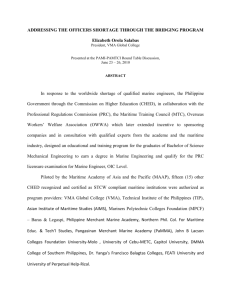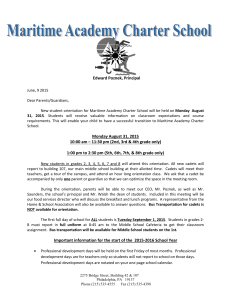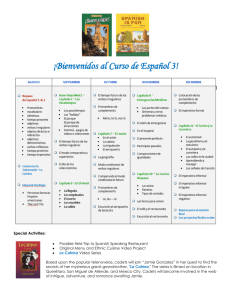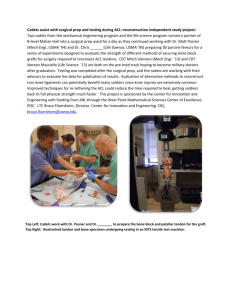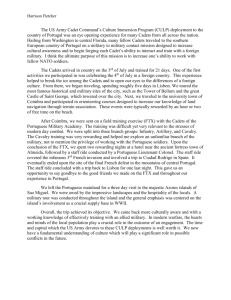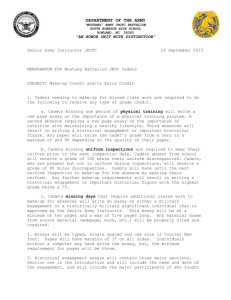baseline survey of three marine protected areas in
advertisement
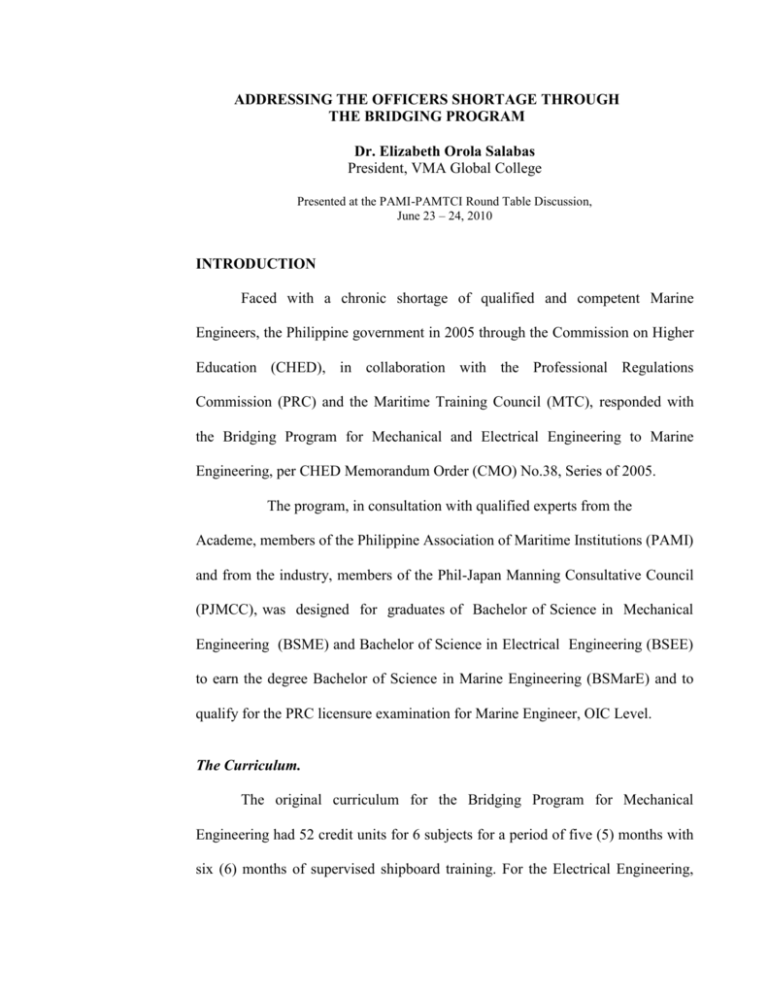
ADDRESSING THE OFFICERS SHORTAGE THROUGH THE BRIDGING PROGRAM Dr. Elizabeth Orola Salabas President, VMA Global College Presented at the PAMI-PAMTCI Round Table Discussion, June 23 – 24, 2010 INTRODUCTION Faced with a chronic shortage of qualified and competent Marine Engineers, the Philippine government in 2005 through the Commission on Higher Education (CHED), in collaboration with the Professional Regulations Commission (PRC) and the Maritime Training Council (MTC), responded with the Bridging Program for Mechanical and Electrical Engineering to Marine Engineering, per CHED Memorandum Order (CMO) No.38, Series of 2005. The program, in consultation with qualified experts from the Academe, members of the Philippine Association of Maritime Institutions (PAMI) and from the industry, members of the Phil-Japan Manning Consultative Council (PJMCC), was designed for graduates of Bachelor of Science in Mechanical Engineering (BSME) and Bachelor of Science in Electrical Engineering (BSEE) to earn the degree Bachelor of Science in Marine Engineering (BSMarE) and to qualify for the PRC licensure examination for Marine Engineer, OIC Level. The Curriculum. The original curriculum for the Bridging Program for Mechanical Engineering had 52 credit units for 6 subjects for a period of five (5) months with six (6) months of supervised shipboard training. For the Electrical Engineering, the curriculum has fourteen (14) academic subjects with 42 units and six months supervised shipboard training for a period of three (3) semesters. PJMCC, now representing Japan Manning Group (JMG), opted to sponsor the bridging program for Mechanical Engineering. In consultation with qualified experts, PJMCC improved the curriculum with the inclusion of additional marine engineering subjects such as: Electro Technology; Marine Automation and Control; and Basic and Advance Swimming with Life Saving. Later, Shipyard Familiarization was included. The program, as embodied in the CHED Memorandum Order No. 38, Series of 2005 dated November 15, 2005 specified: Maritime Academy in Asia & Pacific (MAAP) as the Pilot School and CMO No. 13, Series of 2005 for the Policies, Standards and Guidelines (PSG) for Maritime Education, including the Curriculum. CHED’s recognized maritime institutions compliant to STCW ’95 requirements were enjoined to submit for re-accreditation for CHED to issue Authority to offer and operate the Bridging Program. Recruitment and Selection of Student-Applicants. Initiated by PJMCC, particularly by the K” Line group of manning companies led by Capt. Makoto Kono, Chief Engineer Masami Mitsunaga and Mrs. Virginia Lineses and the former Board Secretary, Mr. Eric Marquez, now FAME President, with the support of school /program providers, linkages with schools, source of graduates of mechanical engineering program, were established as well as the composition of medical laboratory examination package and the accreditation of clinic or hospital. Orientation of students on the industry’s requirements was also conducted. Entry requirements include complete medical examinations, scholastic records and professional license as optional, passing of school/program provider’s entrance examinations and sponsoring manning company’s interview and written examinations. Entrant scholars are required to pass the Neophytes Orientation Program (NOP) undertaking physical, mental and psychological stresses before they are officially recognized as Cadets. Value-Added Program. The Bridging Program was conducted with the students in “a live-in status” within the campus of the school/program provider. The objective of the “live-in” arrangement is to expose the students to an environment similar to the work environment aboardship where they are in a “confined space” away from their family, with limited communication access except in emergency cases and having fixed routine including morning and evening spiritual / devotional activities, physical fitness and value education (Maritime Leadership and Behavior Development or MLBD), an expanded NOP activities to include self awareness, interpersonal relationship, expectation of the industry and discipline as the core of total development. Training requirements such as Basic Safety, Engine Watchkeeping (Ratings Forming Part of Engineering Watch) for the issuance of Seaman’s Book or Seafarers Identification Record Book (SIRB) are facilitated with a training center and included in the bridging cost package. Sponsoring companies, however, have the option to add more training program per their companies’ requirements. The School/program provider likewise facilitates issuance of documentary requirements such as; authenticated birth certificate from the National Statistics Office; NBI clearance; Certification, Authentication and Verification (CAV) from CHED; Passport from the Department of Foreign Affairs; Shipboard Training Record Book from CHED accredited supplier; and the SIRB from Maritime Industry Authority (MARINA). School/Program Providers. CHED’s list of authorized maritime institutions as providers for Bridging Program include; Region 1: Northern Philippines College For Maritime Education & Technical Studies, San Fernando, La Union; and Pangasinan Merchant Marine Academy (PaMMA), Dagupan City; Region III: Philippine Merchant Marine Academy, San Narciso, Zambales; Maritime Academy of Asia and the Pacific, (MAAP), Mariveles, Bataan; Dr. Yanga’s Francisco Balagtas Colleges, Bucaue, Bulacan; Region V: Mariner’s Polytechnic College Foundation (MPCF), Daet, Camarines Sur; and Mariner’s Polytechnic College Foundation (MPCF) Rawis, Legaspi City; Region VI: VMA Global College (formerly Visayan Maritime Academy), Bacolod City; and John B Lacson Foundation University, Molo, Iloilo City; Region VII: University of Cebu-METC, Mambaling Cebu City; Regio XI: Capitol University, Cagayan De Oro City; Region XII: DMMA College of Southern Philippines, Davao City; NCR: Asian Institute of Maritime Studies (AIMS), Pasay City; Technological Institute of the Philippines (TIP), Quiapo, Manila; FEATI University, Sta Cruz, Manila; and University of Perpetual Help, Rizal (UPHR), Las Piñas City. Of the 16 authorized bridging program providers, only six (6) submitted status reports with the rest having to wait for feedback from the students or sponsoring companies. As one of the (16) maritime institutions recognized by CHED to offer the Bridging Program (CBP), VMA Global College debuted with its first batch consisting of 20 cadets on June 5, 2006. As of April 2010, VMA has completed nine (9) batches with a total of 167 cadets. Of the 167 cadets, 99.4% (166 cadets) were sponsored and only 0.6% (1 cadet) paid for his program fees. K Line sponsored 64.67% (108 cadets) while various shipping companies helped 35.33% (58 cadets). The Shipboard Training Phase of the cadets usually lasted over 13 months (30.48%) and 90.91% (120 cadets) got promoted as Wiper due to their excellent performance and readiness for the job. As of April 2010, 102 cadets (61.08%) have completed their Bachelor of Science in Marine Engineering degrees. 28 cadets (16.77%) are still on Shipboard Training, while 34 cadets (20.36%) of the batches 8 and 9 are on Pre Shipboard Training with their respective sponsors and are expected to start their Shipboard Training this July or August 2010. In preparation for their PRC examination for OIC, 99.02% (101 cadets) attended or are currently attending review classes with only 0.98% (1 cadet) on self review. Of the 98 cadets who took the PRC examinations for OIC from January 2008 to May 2010, 100% passed with six (6) cadets included among the Top 10 examinees As to the current status of the CBP cadets, 23.95% (40) are on board as Oilers; 20.36% (34) are Wipers; 14.87% (27) are now either 4/E or 3AE on board; 14.97% (25) are Engine Cadets while 20.36% (34) are preparing for their SBT. In support of the Bridging Program, the Overseas Worker’s Welfare Administration (OWWA) and PJMCC signed a memorandum of agreement providing incentive to sponsoring companies. Thus with the efficient support of shipping companies the Bridge Program at VMA had produced 167 cadets, 120 of whom showed competence and on the job readiness leading to on board promotions right on their first sea duty. Likewise with the aid of review centers, the CBP cadets gave an excellent passing performance of 100% in the PRC board examinations from 2008 to the present with six (6) cadets taking positions in the top ten. More importantly, with loyalty and discipline inculcated in them through rigid academic, physical and psychological training, the CBP has produced competent Marine Engine Officers now continuously serving their respective sponsoring companies on their way to becoming Management Level Engine Officers in the near future.1 1 In collaboration with the Maritime Academy of Asia & Pacific, with grateful appreciation.
